Price: £TBC | Power: 44.3bhp | Weight: 165kg | Overall BikeSocial Rating: TBC
“No bullshit.” That’s KTM’s calling card for new range of single-cylinder naked models led by the all-new 390 Duke – a machine that retains its predecessor’s name but carries over little else from the model that came before.
The original 390 Duke hit the market more than a decade ago as part of KTM’s 2013 range, and was already a familiar face even then, essentially being an enlarged version of the 125 Duke that had arrived in 2011. In the intervening decade there have been tweaks, notably a new headlight for 2017, but most of the bike’s specs have remained unaltered. That changes for the 2024 model year with a completely new chassis, a heavily revised and enlarged engine. Like most model updates the targets are more power and less weight, and KTM appears to have hit both.
Throw in new looks, debuting the latest iteration of KTM’s family ‘face’, and uprated, adjustable suspension and the 390 Duke makes a compelling case for itself as a steppingstone between L-plates and bigger bikes.
Pros and Cons
- Tech including cornering ABS and cornering traction control
- Adjustable suspension at last
- More power from longer-stroke, 399cc single
- The 2024 390 Duke enters a tougher market than its predecessor, with more rivals including several twin-cylinder alternatives
- Little to separate the 390 from the slower 125 in terms of appearance
- Erm… Not a good choice if you don’t like orange bikes?
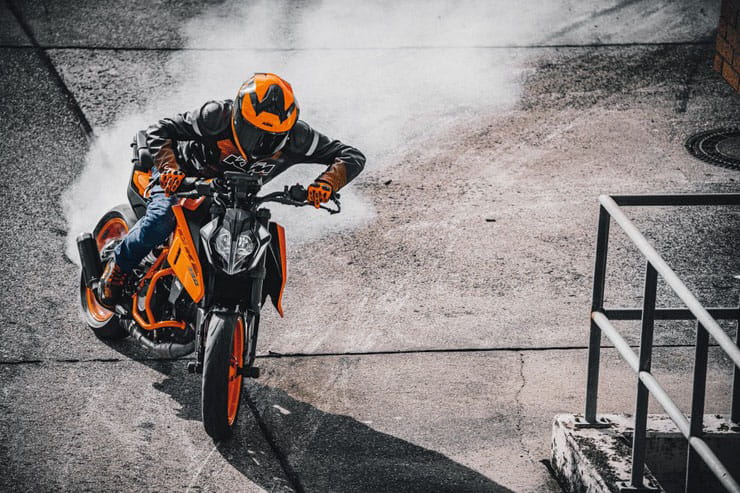
Review – In Detail
Price & PCP
For and against
Engine & Performance
Handling & Suspension (inc. weight & brakes)
Comfort & Economy
Equipment
Rivals
Verdict
Specification
At the time of writing KTM has still to nail down the price of the 2024 390 Duke, but given the 2023 version costs £5,499 it’s safe to expect the new model – which has substantial technical improvements – to be at least that much and probably a little more. But bear in mind that key rivals like Yamaha’s MT-03 are already more expensive, so the 2024 Duke is likely to look competitive.
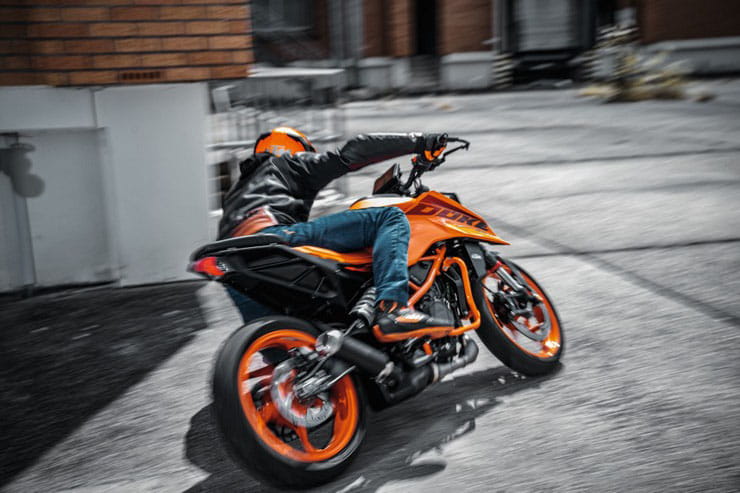
Even from the outside, the new 390 Duke engine looks notably different to the previous model, with new castings for the cases and cylinder, as well as a more compact cylinder head design. Inside, it’s bigger than before, with a capacity hike from 373cc to 399cc courtesy of a longer, 64mm stroke, up from 60mm, while the bore remains unchanged at 89mm.
The extra size adds a little power – up from 43hp for the old 373cc version to 44.3hp for the 399cc bike – but more importantly it brings that peak down from 9,500rpm to 8,500rpm. That points to a bigger boost in torque, and the figures bear that out with a maximum of 28.8 lb-ft at 7,000rpm, up from 25.8 lb-ft at 7,250rpm before.
The new engine, which also forms the basis for the new 125 and 250 Duke models, is dubbed LC4c. The ‘LC4’ bit is familiar KTM terminology – standing for Liquid Cooled, 4-valve – while the lower case ‘c’ at the end mirrors that of the 889cc LC8c used in the 890 Duke and Adventure models, standing for ‘compact’.
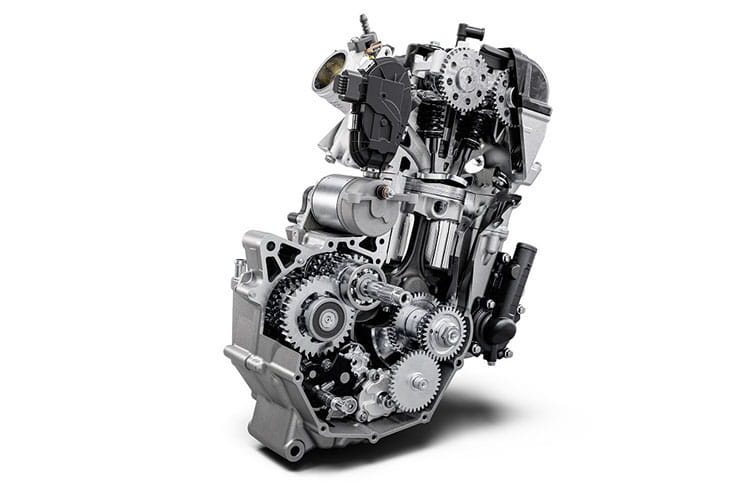
Like the engine, the frame is entirely new, although if you’ve been paying attention, it might look a little familiar – the Husqvarna E-Pilen electric bike prototype, which was wheeled out in public back in 2021, used exactly the same design. That makes sense, as KTM is also known to have been working on an electric Duke based on the same structure, and if both battery-powered and ICE models can share common components it hugely reduces up-front costs for manufacturers.
The frame itself is a steel trellis of the sort we’re used to seeing from KTM, but it’s a rather slimmer and more elegant design than the one used on the original 390 Duke. At the back, the old bike’s steel subframe is replaced with a cast aluminium design, and despite looking more delicate that its predecessor, the new chassis is claimed to have better torsional rigidity, improving rider feedback.
Despite the new chassis, styling and engine, the 2024 390 Duke’s wet weight, including a full tank of fuel, is unchanged from its predecessor, already impressively light at a claimed 154kg.
At the back, a banana-style swingarm arches over the underbelly exhaust – something that was also a feature of the original 390 Duke but was lost as that bike was updated to meet changing emission laws. The swingarm’s curve serves a double purpose, not only clearing the tailpipe but also providing a lower mount for the single, offset rear shock.
As we expect from KTM, all the suspension is from its WP subsidiary, with 43mm APEX forks and a matching APEX shock. Unlike its predecessor, the 2024 390 Duke has adjustable suspension, tweakable for both rebound and compression at the front, and for rebound and preload at the rear.
The brakes, like the old model, feature a single, radial-mount four-pot caliper at the front, from Brembo subsidiary ByBre, grabbing a very slim 320mm disc. At the rear there’s a two-pot caliper and 240mm disk. Unusually for a bike in this part of the market, there’s lean-sensitive, cornering ABS as standard. It’s KTM’s ‘Supermoto ABS’ system, which allows the rear wheel’s anti-lock to be switched off while keeping it active on the front.
The presence of lean-sensors means KTM has also been able to include cornering traction control, and there’s even a launch control system as standard.
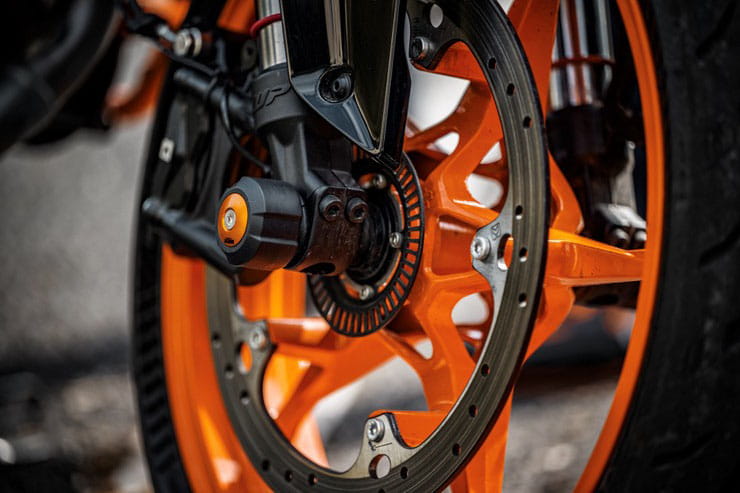
We’ve yet to ride the new 390 Duke and KTM hasn’t made any official claims on economy yet, but its combination of compact proportions, lightweight design and a torquey, single-cylinder engine are a recipe for ease-of-use. KTM’s optional extras will also include an array of protective elements including crash bars, which might be handy for inexperienced buyers.
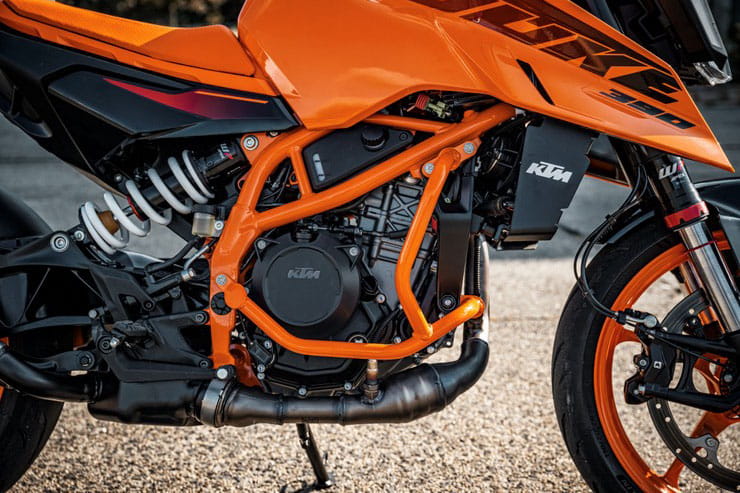
The existing 390 Duke was already among the early adopters for the now-ubiquitous colour TFT screen instead of old-school analogue instruments, and the new model continues that trend and adds to it.
The screen is now a five-inch TFT, with a bonded glass screen for a clean appearance, and gives access to uprated tech including a trio of riding modes – Street, Rain and Track – each altering the bike’s responses. As usual, ‘Rain’ softens throttle response and ratchets up the traction control sensitivity, while ‘Track’ switches the TFT screen to a different layout, emphasising the rev counter and adding a lap timer and gear display as well as the traction control and ABS settings.
There’s turn-by-turn navigation, call answering and music control, too, if you link your phone and install the KTMconnect app.
Elsewhere, the 390 Duke gets new, illuminated bar controls and full LED lighting , as well as standard launch control. Delve into the options list and you can add KTM’s Quickshifter+ up-and-down quickshift, and there will also be a range of bolt on options including a Remus exhaust.
There are plenty of alternatives on the market to make KTM’s life tougher, including both single-cylinder and twin-cylinder alternatives. Yamaha’s MT-03 is perhaps the most obvious one, but in the near future we’re expecting KTM’s Chinese partner company, CFMoto, to bring its new 450NK twin to the UK market, with around 50hp on tap, and don’t ignore Kawasaki’s Z400 and BMW’s G310R, either.
Yamaha MT-03 | Price: £6,005
Power/Torque: 41.4bhp/21.8lb-ft | Weight: 168kg
Kawasaki Z400 | Price: £5,799
Power/Torque: 44.8bhp/27.3lb-ft | Weight: 167kg
BMW G310R | Price: £5,190
Power/Torque: 33.5bhp/20.7lb-ft | Weight: 164kg
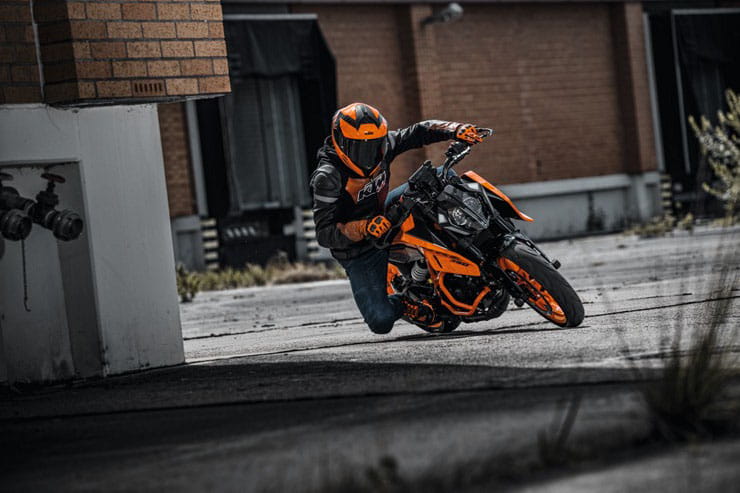
We’ll bring a verdict once we’ve ridden the 2024 KTM 390 Duke.
If you’d like to chat about this article or anything else biking related, join us and thousands of other riders at the Bennetts BikeSocial Facebook page.
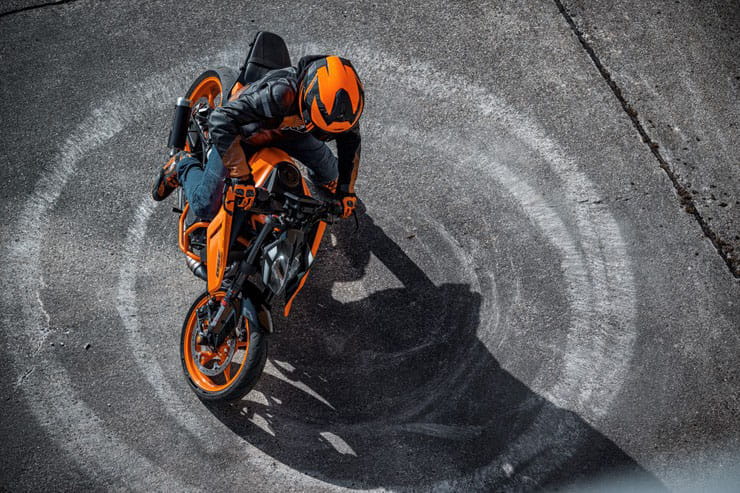
|
New price |
TBA |
|
Capacity |
399cc |
|
Bore x Stroke |
89mm x 64mm |
|
Engine layout |
Single-cylinder |
|
Engine details |
4-valve, liquid-cooled DOHC, fuel-injected |
|
Power |
44.3 (33.1KW) @ 8,500rpm |
|
Torque |
28.8lb-ft (39Nm) @ 7500rpm |
|
Transmission |
6-speed, chain final drive, assist-and-slipper clutch, optional quickshifter |
|
Average fuel consumption |
TBA |
|
Tank size |
TBA |
|
Max range to empty |
TBA |
|
Rider aids |
Launch control, cornering ABS, Supermoto ABS, cornering traction control, three riding modes |
|
Frame |
Steel trellis with cast aluminium subframe |
|
Front suspension |
43mm WP APEX forks |
|
Front suspension adjustment |
Adjustable compression and rebound damping |
|
Rear suspension |
WP APEX monoshock |
|
Rear suspension adjustment |
Adjustable rebound and preload |
|
Front brake |
320mm disc, four-piston ByBre radial caliper |
|
Rear brake |
240mm disc, two-piston ByBre caliper |
|
Front wheel / tyre |
Cast alloy wheel, 110/70 ZR17 |
|
Rear wheel / tyre |
Cast alloy wheel, 150/60 ZR17 |
|
Dimensions (LxWxH) |
TBA |
|
Wheelbase |
1357mm |
|
Seat height |
820mm (800mm optional low seat) |
|
Weight |
165kg wet |
|
Warranty |
2 years/unlimited miles |
|
Servicing |
TBA |
|
MCIA Secured Rating |
Not yet rated |
|
Website |
Looking for motorcycle insurance? Get a quote for this motorbike with Bennetts bike insurance
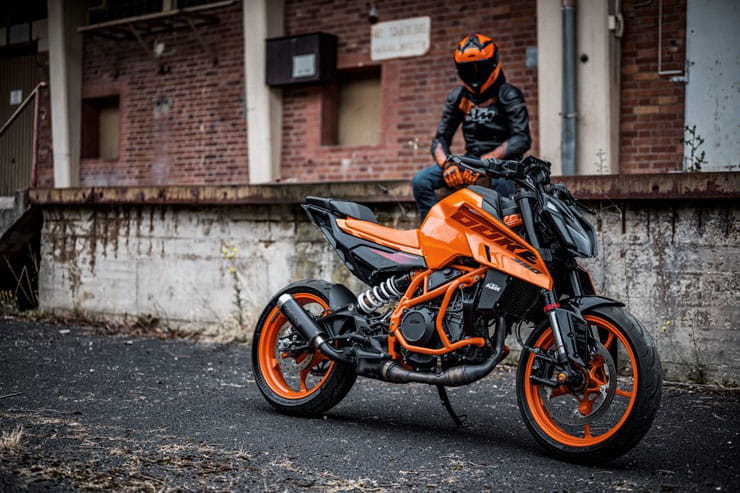
What is MCIA Secured?
MCIA Secured gives bike buyers the chance to see just how much work a manufacturer has put into making their new investment as resistant to theft as possible.
As we all know, the more security you use, the less chance there is of your bike being stolen. In fact, based on research by Bennetts, using a disc lock makes your machine three times less likely to be stolen, while heavy duty kit can make it less likely to be stolen than a car. For reviews of the best security products, click here.
MCIA Secured gives motorcycles a rating out of five stars (three stars for bikes of 125cc or less), based on the following being fitted to a new bike as standard:
- A steering lock that meets the UNECE 62 standard
- An ignition immobiliser system
- A vehicle marking system
- An alarm system
- A vehicle tracking system with subscription
The higher the star rating, the better the security, so always ask your dealer what rating your bike has and compare it to other machines on your shortlist.




